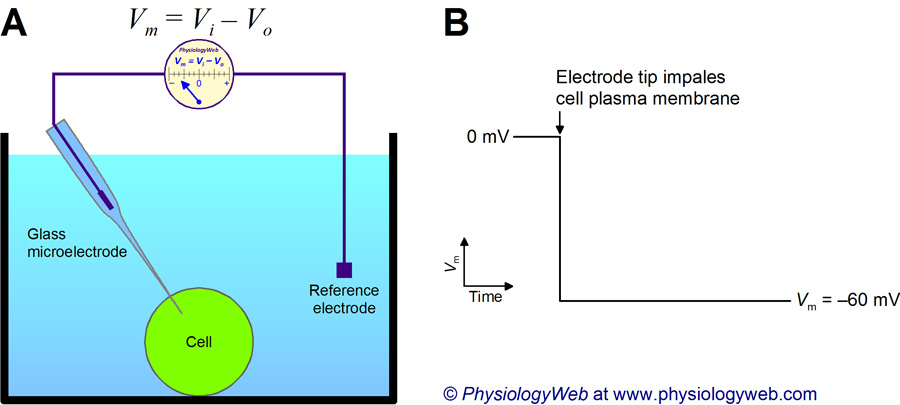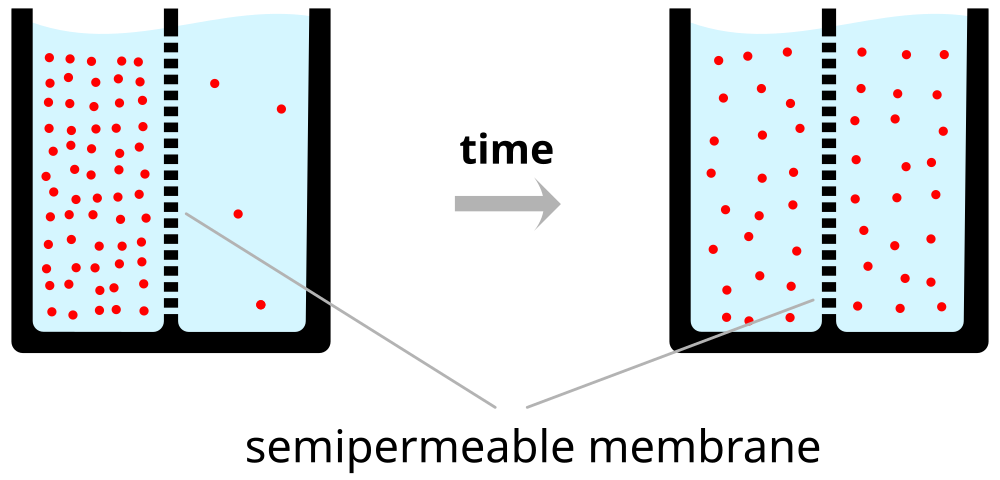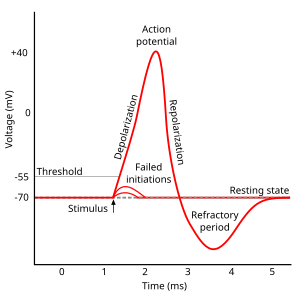2017-02-12 11:54:30
Measuring potentials in actual neurons
Today's Topics
- The neuron at rest
- The neuron in action
Resting potential
Resting potential arises from
- A balance of forces
- Force of diffusion
- Electrostatic force
- Forces cause ion flows across membrane
- Ion channels allow ion flow
Ion channels
- Openings in neural membrane
- Selective
- Vary in permeability
- Types
- Passive/leak
- Voltage-gated
- Ligand-gated (chemically-gated)
- Transporters/pumps
Ion channels
Neuron at rest permeable to K+
- Passive K+ channels open
- [K+] concentration inside >> outside
- K+ flows out
Force of diffusion
Force of diffusion
Neuron at rest permeable to K+
- Organic anions (A-) to large to move outside of cell
- A- and K+ largely in balance == no net internal charge
- K+ outflow creates charge separation: K+ <-> A-
- Charge separation creates a voltage
- Outside +/inside -
- Voltage build-up stops outflow of K+
The resting potential
Balance of forces in the neuron at rest
- Force of diffusion
- K+ moves from high concentration (inside) to low (outside)
Balance of forces in the neuron at rest
- Electrostatic force
- Voltage build-up stops K+ outflow
- Specific voltage called equilibrium potential for K+
- K+ positive, so equilibrium potential negative (w/ respect to outside)
- Equilibrium potential close to neuron resting potential
Equilibrium potential and Nernst equation
Building on intuition
Equilibrium potentials calculated under typical conditions
| Ion | [inside] | [outside] | Voltage |
|---|---|---|---|
| K+ | ~150 mM | ~4 mM | ~ -90 mV |
| Na+ | ~10 mM | ~140 mM | ~ +55-60 mV |
| Cl- | ~10 mM | ~110 mM | - 65-80 mV |
Resting potential ≠ K+ equilibrium potential
- Resting potential not just due to K+
- Other ions flow
- Resting potential == net effects of all ion flows across membrane
Goldman-Hodgkin-Katz equation
Na+ role
- Na+ concentrated outside neuron
- Membrane at rest not very permeable to Na+
- Some, but not much Na+ flows in
- Na+ has equilibrium potential ~ + 60 mV
- Equilibrium potential is positive (with respect to outside)
- Would need positive interior to keep Na+ from flowing in
Electrical circuit model
Summary of forces
| Ion | Concentration gradient | Electrostatic force | Permeability |
|---|---|---|---|
| K+ | Inside >> Outside | - (pulls K+ in) | Higher |
| Na+ | Outside >> Inside | - (pulls Na+ in) | Lower |
Party On
- Annie (A-) was having a party.
- Used to date Nate (Na+), but now sees Karl (K+)
- Hired bouncers called
- "The Channels"
- Let Karl and friends in or out, keep Nate out
- Annie's friends (A-) and Karl's (K+) mostly inside
- Nate and friends (Na+) mostly outside
- Claudia (Cl-) tagging along
What happens if something changes?
- Easier for Karl [K+] to exit?
- Easier for Nate [Na+] to enter?
- Some action!
Action potential
Action potential
- Threshold of excitation
- Increase (rising phase/depolarization)
- Peak
- at positive voltage
- Decline (falling phase/repolarization)
- Return to resting potential (refractory period)
Action potential break-down
| Phase | Neuron State |
|---|---|
| Rise to threshold | + input makes membrane potential more + |
| Rising phase | Voltage-gated Na+ channels open, Na+ enters |
| Peak | Voltage-gated Na+ channels close and deactivate; voltage-gated K+ channels open |
| Falling phase | K+ exits |
| Refractory period | Na+/K+ pump restores [Na+], [K+]; voltage-gated K+ channels close |
What's a Na+/K+ pump?
- Enzyme (Na+/K+ ATP-ase) embedded in neuron membrane
- Pumps Na+ and K+ against concentration gradients
- Na+ out; K+ in
- Uses ATP or chemical energy
Example in another domain
Refractory periods
- Absolute
- Cannot generate action potential (AP) no matter the size of the stimulus
- Voltage-gated Na+ channels inactivated, reactivate in time.
- Relative
- Can generate AP with larg(er) stimulus
- Some voltage-gated K+ channels still open
- Refractory periods put 'spaces' between APs
Generating APs
- Axon hillock
- Portion of soma adjacent to axon
- Integrates/sums input to soma
- Axon initial segment
- Umyelinated portion of axon adjacent to soma
- Voltage-gated Na+ and K+ channels exposed
- If sum of input to soma > threshold, voltage-gated Na+ channels open
Axon hillock, axon initial segment

Axon Hillock" by M.aljar3i - Own work. Licensed under CC BY-SA 3.0 via Commons
Next time
- How action potentials propagate
- Review for Exam 1








